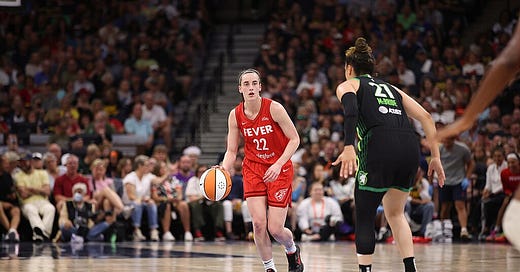Caitlin Clark's star power highlights key problem for LPGA
And while this weekend is historic for the WSL, it could quickly become one of its biggest challenges...
On Saturday, I tuned into the LPGA’s The Annika tournament hoping to catch a glimpse of WNBA superstar Caitlin Clark out on the course.
I dropped the ball because it turns out the pro-am took place on Wednesday, so I completely missed her playing. I really should know better as an avid golf fan.
Caitlin Clark fans, on the other hand, were on it.
Demands for to see her play resulted in the Golf Channel starting their coverage 90 minutes earlier so fans could catch a glimpse of Clark’s drive. (It turns out she’s just like most us and shanks the tee shot every now and again).
Out on the course, she made quite the impact. A tournament spokesperson told Front Office Sports there had been an increase in ticket sales for Wednesday. And it showed in the large crowds that followed her from hole to hole, many fans adorning her jersey or Indiana Fever merchandise and hoping for autographs.
I am surprised the LPGA were caught off guard by the demand to see Caitlin Clark play. The Caitlin Clark effect is well documented. According to Sports Media Watch, since 2008, no WNBA game has averaged more than 1 million viewers until this year when Clark entered the scene and then 23 games hit seven figures in viewership — Clark played in 87% of those games.
It really doesn’t make sense to have Clark teeing off at 7 a.m. when it presents such a big viewership opportunity for the LPGA to introduce a large swathe of women’s sports fans to women’s golf.
And it highlights a key challenge for the LPGA: Star power.
When do you ever see anyone rocking about in LPGA merchandise? (And no, on the golf course doesn’t count)
Of course, those of us who love golf, will count many players as stars. But the LPGA and its players struggle to permeate into culture compared to other sports and being able to do that is going to be key to bringing more fans into this sport.
The LPGA is missing a Tiger Woods, a Michael Jordan, or even a Caitlin Clark. It needs a generational talent, who has an attitude and who can capture the general public’s attention.
Charley Hull could be a contender to be a star for LPGA. Her smoking antics earlier this year certainly caught people’s attention, she’s talented, and she’s cool. She’s also a great player, as I write this newsletter, she’s killing it at The Annika, yet she still hasn’t won a Major. She’s someone fans could really root for.
The LPGA needs to start thinking about star power to grow. I’ve already talked about their sponsorship woes. They need to learn how to cultivate star power, so players can appeal to the masses. This week with The Annika demonstrates that the LPGA doesn’t fully understand the power stars can bring to the growing the game.
The best of the rest
Former Proctor & Gamble executive Deb Henretta makes an angel investment in Women’s Elite Rugby (WER), a 15-a-side women’s rugby league that will launch in the US in 2025.
Athlete Ally estimates that fewer than 40 of 500,000 athletes in the NCAA are transgender. That’s the statistic in an opinion piece from Michigan Daily on how trans panic is being astroturfed, echoing similar views to myself, which I shared last week.
The Premier Lacrosse League will launch a women’s professional lacrosse league in the US in 2025. The launch comes ahead of lacrosse being added to the Olympics in 2028. The sixes format used by the league is also how the game will be played during the Olympics.
There’s a lot of league launching news this week… The Women’s Professional Baseball League (WPBL) has announced plans to launch the first pro league for professional women baseball players in 2026. The last pro league for women, the All-American Girls Professional Baseball League which was immortalized in “A League of Their Own,” shuttered in 1954.
This is a fun one. If you are travelling by tube this weekend then you might hear some familiar voices. England’s Lionesses will make the Tube announcements at various London stations, marking a historic day for the WSL with all games hosted in the City being played in their main stadiums for the first time.
Though it might not actually be an achievement worth celebrating, sharing stadiums with the men’s side is bringing its own challenges to the WSL as highlighted by both The Athletic and The Economist this week.
Women’s soccer attendance is up 24% across the four European leagues, with the WSL experiencing the biggest leap in attendance.
The WNBA Draft Lottery is this evening. Here’s an explainer on how it works.
Image source: John Mac, CC BY-SA 2.0, via Wikimedia Commons



